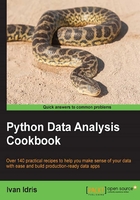
上QQ阅读APP看书,第一时间看更新
A brief of history of data analysis with Python
The history of the various Python software libraries is quite interesting. I am not a historian, so the following notes are written from my own perspective:
- 1989: Guido van Rossum implements the very first version of Python at the CWI in the Netherlands as a Christmas "hobby" project.
- 1995: Jim Hugunin creates Numeric—the predecessor to NumPy.
- 1999: Pearu Peterson wrote f2py as a bridge between Fortran and Python.
- 2000: Python 2.0 is released.
- 2001: The SciPy library is released. Also, Numarray, a competing library of Numeric is created. Fernando Perez releases IPython, which starts out as an "afternoon hack". NLTK is released as a research project.
- 2002: John Hunter creates the Matplotlib library.
- 2005: NumPy is released by Travis Oliphant. NumPy, initially, is Numeric extended with features inspired by Numarray.
- 2006: NumPy 1.0 is released. The first version of SQLAlchemy is released.
- 2007: The scikit-learn project is initiated as a Google Summer of Code project by David Cournapeau. Cython was forked from Pyrex. Cython is later intensively used in pandas and scikit-learn to improve performance.
- 2008: Wes McKinney starts working on pandas. Python 3.0 is released.
- 2011: The IPython 0.12 release introduces the IPython notebook. Packt Publishing releases NumPy 1.5 Beginner's Guide.
- 2012: Packt Publishing releases NumPy Cookbook.
- 2013: Packt Publishing releases NumPy Beginner's Guide, Second Edition.
- 2014: Fernando Perez announces Project Jupyter, which aims to make a language-agnostic notebook. Packt Publishing releases Learning NumPy Array and Python Data Analysis.
- 2015: Packt Publishing releases NumPy Beginner's Guide, Third Edition and NumPy Cookbook, Second Edition.